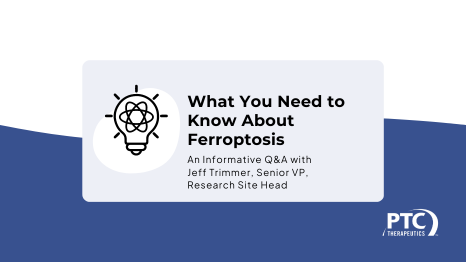Inflammation & Ferroptosis Platform

PTC has pioneered the development of drugs that directly target ferroptosis, a type of programmed cell death caused by iron-dependent oxidation of cell membrane lipids and activation of injurious inflammation pathways.
The Inflammation and Ferroptosis platform includes programs at various stages of preclinical and clinical development focused on translating this expertise into potentially transformational therapies for patients with neurological and other diseases of high unmet need.
Ferroptosis: Programmed Cellular Death that Plays a Significant Role in Multiple Diseases
In ferroptosis, first identified in 2012, iron ions trigger the formation of reactive oxygen species (ROS), oxygen compounds that contain unpaired electrons that make them highly unstable and reactive. Normally, ROS levels within the cell are held in balance by intracellular antioxidants. However, when iron levels are high, the production of ROS can exceed the capacity of the antioxidant system to neutralize them. This imbalance, called oxidative stress, damages the lipid membrane that provides structural integrity to the cell leading to cellular inflammation, injury and, ultimately death. Ferroptosis has been implicated in the pathology of multiple diseases, including neurodegenerative disorders.
Ferroptosis and Inflammation: Self-reinforcing Drivers of Disease
Ferroptosis and inflammation have a complex and bi-directional relationship—on one hand, ferroptosis can stimulate the innate immune response and amplify inflammation, while on the other, inflammation can also activate signaling pathways leading to ferroptosis. This creates a self-reinforcing pathogenic “feedforward” loop in which dysregulation leads to further dysregulation, driving disease.
Our Innovative Platform Targets the Ferroptosis-Inflammatory Cycle
The PTC Inflammation and Ferroptosis Platform leverages this understanding with compounds that target a family of enzymes that regulate ferroptosis known as oxidoreductases. Oxidoreductases facilitate the transfer of electrons between molecules during oxidation reactions and thus play a key role in the peroxidation of lipids in the cell membrane and the activation of other deleterious pro-inflammatory pathways. Targeting oxidoreductases thus suppresses the peroxidation of cell membrane lipids that causes ferroptosis and decreases cellular inflammation, supporting cellular survival and potentially slowing disease progression.
Vatiquinone for the Treatment of Friedreich’s Ataxia
Vatiquinone is being developed for the treatment of Friedreich’s ataxia (FA), a rare, inherited, serious, and life-shortening neurodegenerative disorder with a high-level of unmet medical need.
In FA, a mutation in the frataxin (FXN) gene leads to reduced production of frataxin, a protein that helps regulate cellular iron metabolism. The lack of frataxin causes an accumulation of iron, resulting in increased oxidative stress and ferroptosis. This leads to damage to nerve and muscle tissue, and thus to progressive muscle weakness, and loss of balance and coordination. Vatiquinone inhibits the oxidoreductase 15-Lipoxygenase (15-LO), preventing cell membrane lipid peroxidation, and thus suppressing the feedforward cycle of cellular inflammation and ferroptosis. By promoting the survival of nerve and muscle cells, vatiquinone has the potential to slow FA disease progression.
The PTC Inflammation and Ferroptosis Platform Pipeline
The PTC I&F Platform pipeline of programs targeting enzymes that regulate ferroptosis and inflammation pathways spans the spectrum of development. Pre-clinical stage programs include our alpha-synuclein program, which targets a key aspect of Parkinson’s disease pathology and our nrf-2 activation programs, which target both CNS and peripheral disorders of inflammation and oxidative stress. The PTC844 program targeting the oxidoreductase DHODH to treat neuroinflammatory disorders is in early clinical stages, and a program targeting NLRP3, a potent regulator of inflammation, is in late pre-clinical stages, targeting pulmonary and other organ system disorders in which the NLRP3 inflammasome plays an important role.



